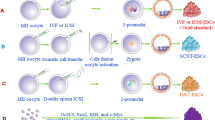Abstract
Achieving successful somatic cell nuclear transfer (SCNT) in the human and subhuman primate relative to other mammals has been questioned for a variety of technical and logistical issues. Here we summarize the gradual evolution of SCNT technology from the perspective of oocyte quality and cell cycle status that has recently led to the demonstration of feasibility in the human for deriving chromosomally normal stem cells lines. With these advances in hand, prospects for therapeutic cloning must be entertained in a conscientious, rigorous, and timely fashion before broad spectrum clinical applications are undertaken.
Similar content being viewed by others
References
Rodriguez-Osorio N, Urrego R, Cibelli JB, Eilertsen K, Memili E. Reprogramming mammalian somatic cells. Theriogenology. 2012;78:1869–86.
Narbonne P, Miyamoto K, Gurdon JB. Reprogramming and development in nuclear transfer embryos and in interspecific system. Curr Opin Genet Dev. 2012;22:450–8.
Noggle S, Fung HL, Gore A, Martinez H, Satriani KG, Prosser R, et al. Human oocytes reprogram somatic cells to a pluripotent state. Nature. 2011;478:70–5.
Yu Y, Yan J, Li M, Yan L, Zhao Y, Lian Y, et al. Effects of combined epidermal growth factor, brain-derived neurotrophic factor and insulin-like growth factor-I on human oocyte maturation and early fertilized and cloned embryo development. Hum Reprod. 2012;27:2146–59.
Tachibana M, Amato P, Sparman M, Gutierrez MM, Tipner-Hedges R, Ma H, et al. Human embryonic stem cells derived by somatic cell nuclear transfer. Cell. 2013;1228–38.
Kishigami S, Wakayama S, Van Thuan N, Ohta H, Mizutani E, Hikichi T, et al. Production of cloned mice by somatic cell nuclear transfer. Nat Protoc. 2006;1:125–38.
Wilmut I, Schnieke AE, McWhir J, Kind AJ, Campbell KHS. Viable offspring derived from fetal and adult mammalian cells. Nature. 1997;386:810–3.
Yamanaka S. Induced pluripotent stem cells: past, present, and future. Cell Stem Cell. 2012;10:678–84.
Ogura A, Inoue K, Wakayama T. Recent advancements in cloning by somatic cell nuclear transfer. Philos Trans R Soc B Biol Sci. 2013;368:20110329.
Morris SA, Daley GQ. A blueprint for engineering cell fate: current technologies to reprogram cell identity. Cell Res. 2013;23:33–48.
Gurdon JB. Nuclear reprogramming in eggs. Nat Med. 2009;15:1141–4.
Willadsen SM. Nuclear transplantation in sheep embryos. Nature. 1986;320:63–5.
Sims M, First NL. Production of calves by transfer of nuclei from cultured inner cell mass cell. Proc Natl Acad Sci USA. 1994;91:6143–7.
Campbell KHS, McWhir J, Ritchie WA, Wilmut I. Sheep cloned by nuclear transfer from a cultured cell line. Nature. 1996;380:64–6.
Nagaoka SI, Hassold TJ, Hunt PA. Human aneuploidy: mechanisms and new insights into an age-old problem. Nat Rev Genet. 2012;13:493–504.
Reynier P, May-Panloup P, Chretien MF, Morgan CJ, Jean M, Savanger F, et al. Mitochondrial DNA content affects the fertilizability of human oocytes. Mol Hum Reprod. 2001;7:425–9.
van den Berg IM, Eleveld C, van der Hoeven M, Birnie E, Steegers EAP, Galjaard RJ, et al. Defective deacetylation of histone 4 K12 in human oocytes is associated with advanced maternal age and chromosome misalignment. Hum Reprod. 2011;26:1181–90.
Li R, Albertini DF. The road to maturation: somatic cell interaction and self-organization of the mammalian oocyte. Nat Rev Mol Cell Bio. 2013;14:141–52.
Hwang WS, Ryu YJ, Park JH, Park ES, Lee EG, Koo JM, et al. Evidence of a pluripotent human embryonic stem cell line derived from a cloned blastocyst. Science. 2004;303:1669–74.
Hwang WS, Roh SI, Lee BC, Kang SK, Kwon DK, Kim S, et al. Patient-specific embryonic stem cells derived from human SCNT blastocyst. Science. 2005;308:1777–83.
Stojkovic M. Derivation of a human blastocyst after heterologous nuclear transfer to donated oocytes. Reprod Biomed Online. 2005;11:226–31.
Hall VJ, Compton D, Stojkovic P, Nesbit M, Herbert M, Murdoch A, et al. Developmental competence of human in vitro aged oocytes as host cells for nuclear transfer. Hum Reprod. 2007;22:52–62.
Heindryckx B, De Sutter P, Gerris J, Dhont M, Van der Elst. Embryo development after successful somatic cell nuclear transfer to in vitro matured human germinal vesicle oocytes. Hum Reprod. 2007;22:1982–90.
Chung Y, Bishop CE, Treff NR, Walker SJ, Sandler VM, Becker S, et al. Reprogramming of human somatic cells using human and animal oocytes. Cloning Stem Cells. 2009;11:213–23.
French AJ, Adams CA, Anderson LS, Kitchen JR, Hughes MR, Wood SH. Development of human cloned blastocysts following somatic cell nuclear transfer with adult fibroblasts. Stem Cells. 2008;26:485–93.
Modlinski JA. Transfer of embryonic nuclei to fertilized mouse eggs and development of tetraploid blastocysts. Nature. 1978;273:466–7.
Surani MAH, Barton SC, Norris ML. Nuclear transplantation in the mouse: heritable differences between parental genomes after activation of the embryonic genome. Cell. 1986;45:127–36.
Byrne JA, Pedersen DA, Clepper LL, Nelson M, Sanger WG, Gokhale S, et al. Producing primate embryonic stem cells by somatic cell nuclear transfer. Nature. 2007;450:497–502.
Fulka Jr J, Mrazek M, Fulka H, Loi P. Mammalian oocyte therapies. Cloning Stem Cells. 2005;7:183–188.26.
Tachibana M, Sparman M, Sritanaudomchai H, Ma H, Clepper L, Woodward J, et al. Mitochondrial gene replacement in primate offspring and embryonic stem cells. Nature. 2009;461:367–72.
Craven L, Tuppen H, Greggains GD, Harbottle SJ, Murphy JL, Cree LM, et al. Pronuclear transfer in human embryos to prevent transmission of mitochondrial DNA disease. Nature. 2010;465:82–5.
Tachibana M, Amato P, Sparman M, Woodward J, Melguizo Sanchis D, Ma H, et al. Toward germline gene therapy of inherited mitochondrial diseases. Nature. 2013;493:627–31.
Paull D, Emmanuele V, Weiss KA, Treff N, Stewart L, Hua H, et al. Nuclear genome transfer in human oocytes eliminates mitochondrial DNA variants. Nature. 2013;493:632–7.
Acknowledgments
HF is supported from GACR P302/11/P069. JFJr is supported from GACR 13-03269S. DFA is supported by a grant from the ESHE Fund.
Author information
Authors and Affiliations
Corresponding author
Additional information
Capsule This paper is dedicated to the memory of Keith Campbell (1954–2012), a pioneer in the field of somatic cell nuclear transfer.
Rights and permissions
About this article
Cite this article
Fulka, J., Langerova, A., Loi, P. et al. The ups and downs of somatic cell nucleus transfer (SCNT) in humans. J Assist Reprod Genet 30, 1055–1058 (2013). https://doi.org/10.1007/s10815-013-0053-7
Received:
Accepted:
Published:
Issue Date:
DOI: https://doi.org/10.1007/s10815-013-0053-7




